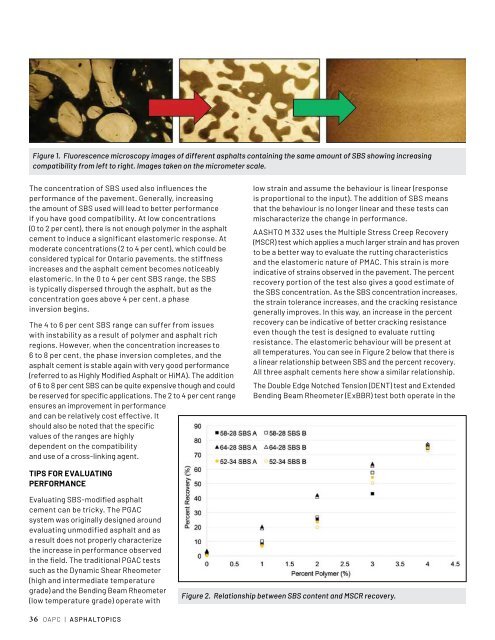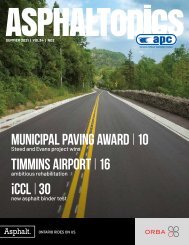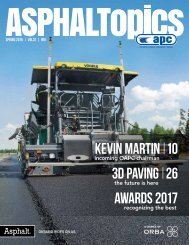ASPHALTopics | Fall 2020 | VOL 33 | NO 3
Create successful ePaper yourself
Turn your PDF publications into a flip-book with our unique Google optimized e-Paper software.
Figure 1. Fluorescence microscopy images of different asphalts containing the same amount of SBS showing increasing<br />
compatibility from left to right. Images taken on the micrometer scale.<br />
The concentration of SBS used also influences the<br />
performance of the pavement. Generally, increasing<br />
the amount of SBS used will lead to better performance<br />
if you have good compatibility. At low concentrations<br />
(0 to 2 per cent), there is not enough polymer in the asphalt<br />
cement to induce a significant elastomeric response. At<br />
moderate concentrations (2 to 4 per cent), which could be<br />
considered typical for Ontario pavements, the stiffness<br />
increases and the asphalt cement becomes noticeably<br />
elastomeric. In the 0 to 4 per cent SBS range, the SBS<br />
is typically dispersed through the asphalt, but as the<br />
concentration goes above 4 per cent, a phase<br />
inversion begins.<br />
The 4 to 6 per cent SBS range can suffer from issues<br />
with instability as a result of polymer and asphalt rich<br />
regions. However, when the concentration increases to<br />
6 to 8 per cent, the phase inversion completes, and the<br />
asphalt cement is stable again with very good performance<br />
(referred to as Highly Modified Asphalt or HiMA). The addition<br />
of 6 to 8 per cent SBS can be quite expensive though and could<br />
be reserved for specific applications. The 2 to 4 per cent range<br />
ensures an improvement in performance<br />
and can be relatively cost effective. It<br />
should also be noted that the specific<br />
values of the ranges are highly<br />
dependent on the compatibility<br />
and use of a cross-linking agent.<br />
low strain and assume the behaviour is linear (response<br />
is proportional to the input). The addition of SBS means<br />
that the behaviour is no longer linear and these tests can<br />
mischaracterize the change in performance.<br />
AASHTO M <strong>33</strong>2 uses the Multiple Stress Creep Recovery<br />
(MSCR) test which applies a much larger strain and has proven<br />
to be a better way to evaluate the rutting characteristics<br />
and the elastomeric nature of PMAC. This strain is more<br />
indicative of strains observed in the pavement. The percent<br />
recovery portion of the test also gives a good estimate of<br />
the SBS concentration. As the SBS concentration increases,<br />
the strain tolerance increases, and the cracking resistance<br />
generally improves. In this way, an increase in the percent<br />
recovery can be indicative of better cracking resistance<br />
even though the test is designed to evaluate rutting<br />
resistance. The elastomeric behaviour will be present at<br />
all temperatures. You can see in Figure 2 below that there is<br />
a linear relationship between SBS and the percent recovery.<br />
All three asphalt cements here show a similar relationship.<br />
The Double Edge Notched Tension (DENT) test and Extended<br />
Bending Beam Rheometer (ExBBR) test both operate in the<br />
TIPS FOR EVALUATING<br />
PERFORMANCE<br />
Evaluating SBS-modified asphalt<br />
cement can be tricky. The PGAC<br />
system was originally designed around<br />
evaluating unmodified asphalt and as<br />
a result does not properly characterize<br />
the increase in performance observed<br />
in the field. The traditional PGAC tests<br />
such as the Dynamic Shear Rheometer<br />
(high and intermediate temperature<br />
grade) and the Bending Beam Rheometer<br />
(low temperature grade) operate with<br />
Figure 2. Relationship between SBS content and MSCR recovery.<br />
36 OAPC | ASPHALTOPICS

















